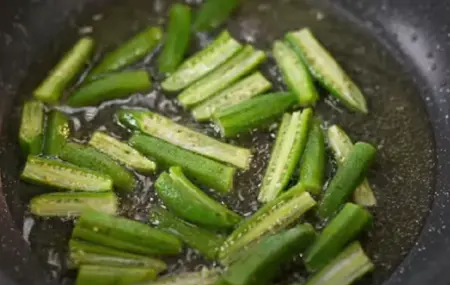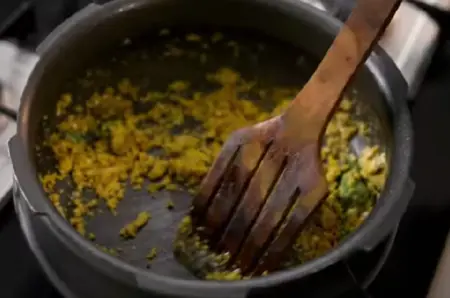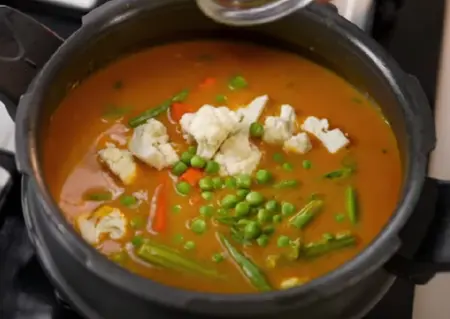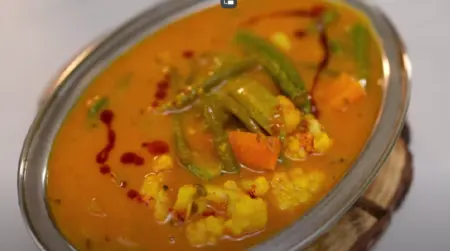
Sindhi Kadhi recipe

25 Mins

5-6 People

20 Mins
How to Make Sindhi Kadhi Recipe
Introduction:
Experience the authentic flavors of the Sindhi cuisine with our tantalizing Sindhi Kadhi recipe. This iconic dish is a melange of tangy and savory flavors, showcasing the vibrant essence of Sindhi culinary heritage. Packed with a variety of vegetables and the zesty touch of tamarind, this curry offers a delightful sweet and sour taste that's truly unique. The base of gram flour, or besan, gives this dish a smooth and velvety texture, making it a comforting choice for any meal.
Delve into the world of Sindhi cuisine as you savor the delightful combination of flavors in this traditional Sindhi Kadhi. The dish is an embodiment of the rich heritage and diverse culinary expertise of the Sindhi community. Let's unravel the secrets of preparing this beloved dish and bring the taste of Sindhi flavors to your dining table.
Ingredients of Sindhi Curry
-
Tomatoes: 2 pcs
-
Water
-
Oil: ¼ cup
-
Bhindi (Okra): ½ cup
-
Oil: 1 tbsp
-
Jeera (Cumin Seeds): 1 tsp
-
Mustard seeds: ½ tsp
-
Methi seeds (Fenugreek Seeds): ½ tsp
-
Curry leaves: 8-10 pcs
-
Besan (Gram Flour): 1 cup
-
Hot water as required
-
Turmeric powder: ½ tsp
-
Red chilli powder: 1 tsp
-
Green chilli, chopped: 1 tbsp
-
Ginger, chopped: ½ tbsp
-
Drumstick: ½ cup
-
French beans: ½ cup
-
Carrot: ½ cup
-
Cauliflower: ½ cup
-
Green peas: ¼ cup
-
Parval: ½ cup
-
Potato wedges: ½ cup
-
Tamarind water: 1 tbsp
-
Salt: 1 tbsp
Instructions of Sindhi Curry
1. Preparing the Tomatoes:
Pressure cook the tomatoes in water for 2 whistles until they are tender. Once done, blend the cooked tomatoes into a smooth paste and set it aside.
2. Prepping the Bhindi:
Slice the bhindi horizontally into bite-sized pieces after trimming both ends.
3. Frying the Bhindi:
Shallow fry the sliced bhindi until it turns golden and crispy. Once fried, set it aside.

4. Starting the Curry Base:
Heat ¼ cup of oil in a pressure cooker. Add jeera, mustard seeds, methi seeds, and curry leaves. Roast the besan until it becomes aromatic, then add hot water gradually while stirring.

5. Creating the Spice Mix:
Add turmeric powder, red chilli powder, chopped green chilli, and chopped ginger to the curry base. Stir well to combine.
6. Creating the Vegetable Medley:
Gradually add hot water to the pressure cooker, followed by the mixed vegetables and the tomato paste. Incorporate tamarind water and salt into the mixture.

7. Pressure Cooking:
Cook the mixture for 2 whistles on medium heat, allowing the vegetables to become tender and the flavors to meld together.

8. Final Touch:
Add the fried bhindi to the curry and cook for an additional minute to blend the flavors.
9. Serving the Sindhi Curry:
Serve the Sindhi Curry hot with steamed rice or roti.

In conclusion, this Sindhi Kadhi isn't just a recipe; it's a gateway to the vibrant and tangy world of Sindhi cuisine. Its blend of flavors, from the sourness of tamarind to the earthy besan base, presents a delectable solution for those craving authentic Sindhi flavors.
Explore more delightful recipes by Chef Ajay Chopra to embark on a culinary adventure through various regional Indian cuisines. Check out his courses and books to delve deeper into the intricacies of Indian cooking and enjoy the myriad flavors and aromas of this diverse cuisine in your own kitchen.
FAQs (Frequently Asked Questions)
Question 1: What makes Sindhi Kadhi unique?
Answer 1: Sindhi Kadhi stands out due to its tangy and savory taste, thanks to the combination of vegetables, tamarind, and besan.
Question 2: Can I make Sindhi Kadhi without vegetables?
Answer 2: While vegetables are a key component, you can adjust the variety or quantity based on preference, but they significantly contribute to the dish's flavor.
Question 3: Is tamarind essential in Sindhi Kadhi?
Answer 3: Yes, tamarind plays a crucial role, offering the distinctive sweet and sour taste that defines Sindhi Kadhi.
Question 4: What is the base of Sindhi Kadhi?
Answer 4: Gram flour, also known as besan, forms the base of Sindhi Kadhi, lending it a smooth and thick consistency.
Question 5: Can I alter the sweetness or sourness of the Kadhi?
Answer 5: Absolutely, you can adjust the levels of tamarind or sweetness based on personal preference to balance the flavors.
Question 6: Which vegetables are commonly used in Sindhi Kadhi?
Answer 6: Vegetables like ladyfinger (okra), drumsticks, and bhindi (okra) are frequently used in Sindhi Kadhi.
Question 7: Is this dish suitable for a no-onion, no-garlic diet?
Answer 7: Yes, you can prepare Sindhi Kadhi without onion and garlic by adjusting the recipe accordingly.
Question 8: What is the best way to serve Sindhi Kadhi?
Answer 8: Sindhi Kadhi pairs wonderfully with steamed rice, making for a wholesome and satisfying meal.
